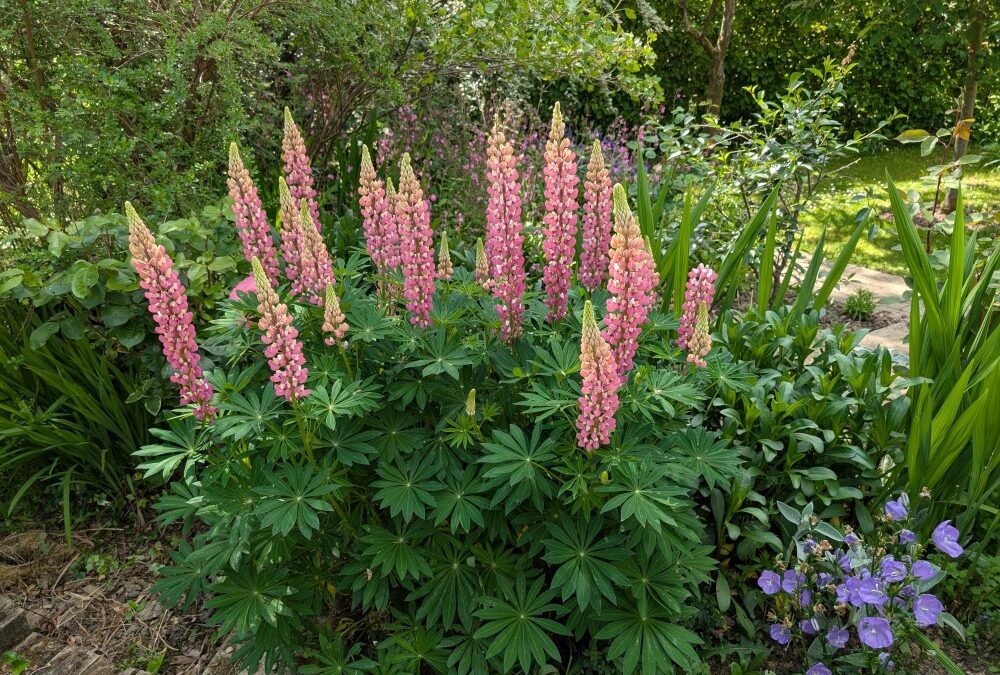Gardening Jobs for May in the UK
May is a magical month for gardeners across the UK. The days are brighter, the evenings stretch out longer, and everything seems to be bursting into life after the chilly start to spring. Yet, for all its charm, May can be a little testing too. Many of the garden’s early stars, such as daffodils and tulips, are fading fast, and it’s tempting to reach for the secateurs and tidy them away. Resist that urge. Cutting the foliage back too soon means the bulbs miss their chance to store valuable nutrients for next year, often leaving you with leaves but no flowers when spring rolls around again. Wait until the leaves have flopped and turned brown before tidying them up, and you’ll be rewarded with an even better display next year.
“May is the bridge between spring and summer—a month to nurture, plant, and prepare while also pausing to enjoy the garden in bloom.”
With that advice in mind, May remains a time to celebrate the joy of gardening. There’s planting to be done, borders to tend, and lawns that will thank you for a little extra attention. It’s also the season when you can finally relax in your garden, enjoying the rewards of spring’s hard work while preparing for a colourful summer ahead.
Looking After the Lawn

May is a crucial month for lawn care in the UK, as grass grows strongly in response to longer days and warmer temperatures. For the best results, mow twice a week, though a weekly cut will still keep things looking neat. Cutting little and often is better than letting the grass get long and taking off too much at once, which stresses the lawn and weakens the roots.
Adjust your mower height depending on the weather. If the month turns dry, raise the blades a little to prevent the grass from being cut too short, which can leave it prone to yellowing. Feeding with a spring lawn fertiliser is also worthwhile at this time of year, as the nitrogen boost helps grass grow thick and green, giving it the strength to outcompete weeds and moss.
Don’t overlook the finishing touches either. Neat lawn edges give the whole garden a lift, and tackling weeds like dandelions before they go to seed keeps the lawn looking pristine. With a little care now, your lawn can become the perfect setting for summer gatherings.
Pull-Quote: “Little and often is the golden rule of mowing—your lawn will thank you for it.”
Planting and Sowing in May
Now that the soil has warmed, May feels like the true beginning of the growing season. April’s unpredictable mix of warm days and frosty mornings often keeps gardeners on edge, but by May most of that uncertainty is behind us. The vegetable patch comes into its own this month, and it’s safe to plant beans and courgettes directly into the ground. Outdoor tomatoes can also take their place in well-prepared soil, while quick crops such as lettuce, radish, and beetroot can be sown in succession for a steady harvest all summer long.
Flower borders can be given new life too. Dahlia tubers, which may have been lifted and stored over winter, can now be returned to the earth. Not only do they provide a bold splash of colour later in the season, but lifting them annually is a brilliant way of increasing your stock. Gladioli, with their tall spires, and lilies, with their fragrant blooms, can also be planted now to extend your summer display.
Tender bedding plants bring instant impact. Petunias and begonias fill pots, troughs, and flowerbeds with cheerful colour, while trailing plants such as Bacopa are perfect for hanging baskets. Planting them now ensures your containers will be full and vibrant well into autumn, transforming patios and doorways into welcoming displays.
Top Tip Box: Harden off tender bedding plants by placing them outside during the day and bringing them in at night for a week or two before planting out permanently. It helps them cope with temperature swings.
Pruning and Maintenance
As one wave of flowers fades, another begins, and pruning is an important task in May. Many spring-flowering shrubs benefit from a trim as soon as their blooms are spent. Forsythia, with its sunshine-yellow flowers, is best cut back now to encourage vigorous growth. Flowering currants, or Ribes, also appreciate a tidy-up at this time, while Choisya, the Mexican Orange Blossom, can be lightly shaped with shears or a hedgetrimmer to keep it neat and healthy.
Hedges also make their first strong push of the season, and fast-growing varieties like privet and Leylandii will likely need their first cut by the end of May. Shaping them early sets the tone for the rest of the season, keeping them in check and looking their best.
Roses, too, demand attention. With buds forming and flowers beginning to open, regular deadheading is essential to encourage repeat flowering. A feed with a rose-specific fertiliser helps sustain their energy for the long summer ahead, and it’s worth keeping a close eye out for aphids, which can multiply quickly. A gentle spray of soapy water, or simply rubbing them off by hand, can keep infestations under control, especially if you prefer a more organic approach.
“Deadheading roses in May keeps the flowers coming right through the summer.”
Beds and Borders
The warming soil is a gift not only to your plants but also to weeds, which will thrive if left unchecked. Staying on top of them in May makes life easier later in the season. Hoeing between rows on a dry day is an efficient way to deal with them, while hand-weeding is often the best choice in densely planted beds.
Mulching is another job worth doing now. By spreading a layer of organic matter around your plants, you can suppress weeds while helping the soil retain valuable moisture. Just remember to water the beds thoroughly before mulching; sealing dry soil beneath a mulch layer can starve your plants of the water they need.
Feeding is also key to keeping borders looking vibrant. Roses, clematis, and summer bedding respond well to a general fertiliser, which encourages lush growth and a more generous display of flowers.
Did You Know? A good mulch doesn’t just suppress weeds—it can also improve soil structure and encourage earthworms, which aerate your soil naturally.
Greenhouse and Containers

For gardeners with greenhouses, May is one of the busiest months. Tender plants that have been protected through the spring are now ready to be hardened off, spending days outdoors before being planted out permanently. Ventilation is key, as greenhouses can heat up quickly in the sunshine, and regular watering prevents young plants from drying out.
Containers and hanging baskets also come into their own this month. A weekly liquid feed encourages lush growth and a steady supply of flowers, while consistent watering keeps displays looking their best. Investing the time now ensures that patios, balconies, and courtyards remain colourful right through the summer.
Welcoming Wildlife

A garden in May is not just for people—it’s also a haven for wildlife. Allowing a patch of lawn to grow longer provides a valuable habitat for pollinators, while planting nectar-rich flowers such as foxgloves, lavender, and verbena will attract bees and butterflies in abundance.
Birds benefit from a shallow dish of fresh water placed in a safe spot, and if you’re patient, you might even see hedgehogs visiting in the evenings in search of slugs and snails. By creating a wildlife-friendly garden, you’re not only supporting biodiversity but also benefiting from natural pest control.
Enjoying the Garden
Amid all the planting, pruning, and lawn care, it’s important not to forget the true joy of gardening: enjoying the space you’ve created. May offers long evenings that are perfect for sitting outside, whether you’re entertaining friends, enjoying a meal al fresco, or simply soaking up the sights and sounds of nature.
Gardening in May is about laying the groundwork for the summer months, giving your plants the best possible start while taking the time to appreciate the beauty of the season. Whether you’re a beginner planting your first flowers or a seasoned gardener refining your borders, May is a reminder that the garden is a place of growth, renewal, and enjoyment.
Post’s you might like; April’s Gardening Jobs and Gardening Tips for June.

